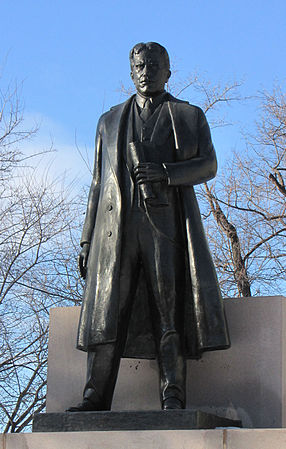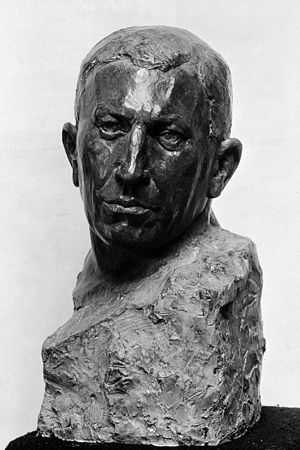Frances Loring
Frances Loring | |
|---|---|
 | |
| Born | October 14, 1887 Wardner, Idaho, United States |
| Died | February 5, 1968 (aged 80) Newmarket, Ontario, Canada |
| Nationality | Canadian |
| Education | Art Institute of Chicago |
| Known for | sculptor |
Notable work | Queen Elizabeth Way Monument; |
| Movement | Neo-classical |
Frances Norma Loring, RCA, (October 14, 1887– February 5, 1968) was a Canadian sculptor. Loring studied in Europe before enrolling at the Art Institute of Chicago, where she studied with Lorado Taft. She was a member of both the Royal Canadian Academy of Arts and the Ontario Society of Artists. Later she was involved in the organization of the Federation of Canadian Artists (1941) and the Canada Council (1950s). In 1960 she was the Canadian representative at the Venice Biennale. Loring was the creator of two notable sculptures in Canada, Queen Elizabeth Way Monument (1939), located now in Toronto and a statue of Robert Borden (1957), located on Parliament Hill, Ottawa.[1][2]
Loring is closely associated with fellow sculptor Florence Wyle, and they became two of the earliest prominent Canadian sculptors. The relationship between Loring and Wyle was both personal and professional and lasted for over 60 years after they first met at the Art Institute of Chicago in 1905. The two women collaborated on multiple projects and both had a significant influence on Canadian art by promoting sculpture as being as important as any other art form. Loring and Wyle had moved into an abandoned church in 1920, and it served as both their home and studio. After their sculptures gained some popularity, the church became headquarters for the Sculptors Society of Canada, where Loring and Wyle both considered as the founding members.[1]
Biography[]
Loring was born in Wardner, Idaho on October 14, 1887 to mining engineer Frank Curtis Loring (1859-1938) and Charlotte Moore.[2][3][4] Loring studied at multiple schools including the Ecole des Beaux-Arts in Switzerland, the Academie Colarossi in Paris, the Art Institute of Chicago, the School of the Museum of Fine Arts at Tufts in Boston, and at the Art Students League of New York.
At the Art Institute of Chicago Loring met Florence Wyle with whom she was to have a lifelong partnership. In 1909 Loring moved to New York City and was soon joined by Wyle. The first of the three studio homes they would share over their lives was located on MacDougal Alley, a lively artist colony in the heart of Greenwich Village. Living at no. 6, a converted stable with additional living space, they sculpted well-known portrait busts of each other.
In 1913, Loring and Wyle moved to Toronto, where they began being referred to as "The Girls."[5] Both of them quickly became major forces in the city and across the country, getting major commissions during World War I and II. In Toronto they rented a studio-home that occupied the top-floor above a carpenters shop at the corner of Church and Lombard Street called Hunters Inn. Eight years later, in 1920, Frances (aged 33) and Florence (aged 39) bought "The Church" at 110 Glenrose Avenue in the Moore Park neighborhood.[6] The Loring-Wyle Parkette, located beside "The Church," is now home to their sculpture busts of each other.[5] In 1928 Loring and Wyle were founding members of the Sculptors' Society of Canada with Alfred Laliberté, Elizabeth Wyn Wood, Wood's teacher and husband Emanuel Hahn and Henri Hébert. In addition to being their studio-home, The Church became the official head office for the Sculptors' Society of Canada and a gathering place for Toronto's artistic community. A. Y. Jackson called The Church "the most fascinating gathering place in the country" and it has been described as the closest Toronto came to having a Bohemian salon. Robertson Davies based characters on them and The Church in The Cunning Man.[7]
Loring was made a member of the Royal Canadian Academy of Arts and was the chief organizer of the Federation of Canadian Artists and the Canada Council of the Arts.[8] Her work was often exhibited by the Women's Art Association of Canada.[9] In 1960, works by Loring along with those of Edmund Alleyn, Graham Coughtry, Jean Paul Lemieux and Albert Dumouchel represented Canada at the Venice Biennale.[10]
Artistic career[]

Frances Loring created hundreds of different pieces of art in a large variety of materials, including public monuments, sculptures and memorials during the First World War, war memorials after the war, architectural sculptures, portraits, and garden sculptures.[7][11] Commissions included those by the Canadian War Memorial Fund and the City of Toronto government to create sculptures of women on the Canadian home front. For the Queen Elizabeth Way Monument, a monument for Queen Elizabeth and her husband, King George VI, Loring designed and carved the lion and column, and Wyle carved the much smaller King and Queen in relief. Known as the Lion Monument and as the Loring Lion, has been located in Casimir Gzowski Park in Toronto, Ontario, since 1975. Loring also created a portrait of Prime Minister Robert Borden in bronze and various war memorials in Cambridge, Ontario.
In 1965, Loring and Wyle made mirroring wills that called for the creation of The Sculpture Fund, an acquisition fund for museums, galleries and places of learning to purchase sculpture. They died three weeks apart in 1968. While their intention was to leave all their money from estate sales to support a new generation of Canadians sculptors, The Sculpture Fund was not fulfilled.[12][13]
Works[]

Frances Loring's Sir Robert Borden (1957) at Parliament Hill Ottawa, Ontario

Frances Loring's Lion sculpture at the base of the Queen Elizabeth Way Monument

Head of Sir Frederick Banting - National Gallery of Canada
Further reading[]
- Cameron, Elspeth (2007). And Beauty Answers: The Life of Frances Loring and Florence Wyle. Toronto: Comorant Books. ISBN 978-1-897151-13-6.
- Sisler, Rebecca (1972). The Girls : a biography of Frances Loring and Florence Wyle. Toronto: Clarke, Irwin & Company. ISBN 978-0-7720-0578-6.
References[]
- ^ Jump up to: a b Sisler, Rebecca. "Frances Norma Loring". The Canadian Encyclopedia. Retrieved 2017-03-08.
- ^ Jump up to: a b Amy Marshall Furness and Gary Fitzgibbon, Description and Finding Aid: Frances Loring and Florence Wyle Fonds, 2008, accessed 9 June 2014
- ^ Merna Forster, "The Grand Dame of Canadian Sculpture - Frances Loring 1887 - 1968" In: 100 More Canadian Heroines: Famous and Forgotten Faces (Toronto, Dundurn, 2011), Volume 2 of Canadian Heroines, p.229, accessed 9 June 2014
- ^ "Francis Loring" Archived 2014-07-14 at the Wayback Machine, Lawrence Hayward Collection (website), accessed 9 June 2014
- ^ Jump up to: a b Rebecca Sisler, "The Girls: A Biography of Frances Loring and Florence Wyle" 1972 Clarke, Irwin & Company
- ^ Goddard, Peter (2007-12-01). "Book examines sculptures of Loring and Wyle". Toronto Star. Retrieved 2007-12-04.
- ^ Jump up to: a b Cameron, Elspeth (2007). And Beauty Answers: The Life of Frances Loring and Florence Wyle. Cormorant Books Inc. ISBN 1897151136.
- ^ "Members since 1880". Royal Canadian Academy of Arts. Archived from the original on 26 May 2011. Retrieved 11 September 2013.
- ^ Holmlund, Mona; Youngberg, Gail (2003). Inspiring Women: A Celebration of Herstory. Coteau Books. p. 216. ISBN 978-1-55050-204-6. Retrieved 2014-07-05.
- ^ "Past Canadian Exhibitions". National Gallery of Canada at the Venice Biennale. National Gallery of Canada. Archived from the original on 13 October 2013. Retrieved 12 October 2013.
- ^ Sisler, Rebecca (1972). "Lives and Works of the Canadian Artists". Dundurn Press.
- ^ Encyclopedia, Canadian. "Frances Loring". Canadian Encyclopedia. Canadian Encyclopedia. Retrieved 7 March 2017.
- ^ "Frances Loring, Florence Wyle". Library and Archives Canada. Government of Canada. Archived from the original on 4 December 2019. Retrieved 2 April 2020.
External links[]
| Wikimedia Commons has media related to Frances Loring. |
- Collections Canada article
- Canadian Encyclopedia article
- Frances Loring archival papers at the Art Gallery of Ontario research library and archives
- "Loring and Wyle collection". University of Waterloo Library. Special Collections & Archives. 22 July 2014. Retrieved 4 January 2018.
- 1887 births
- 1968 deaths
- Canadian architectural sculptors
- Canadian sculptors
- Canadian women artists
- Members of the Royal Canadian Academy of Arts
- 20th-century sculptors
- 20th-century American women artists
- Lesbian artists
- LGBT artists from the United States
- LGBT artists from Canada
- Persons of National Historic Significance (Canada)


